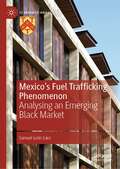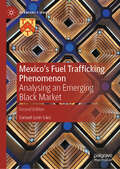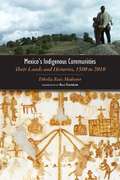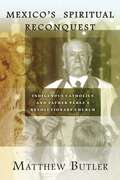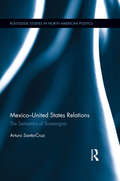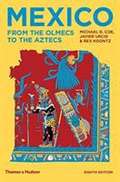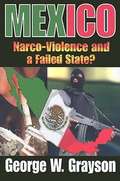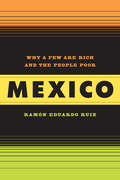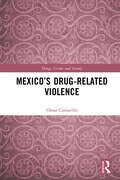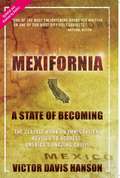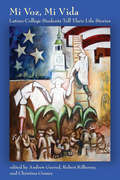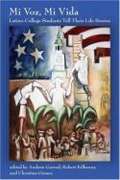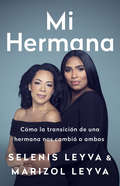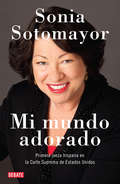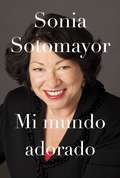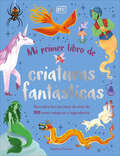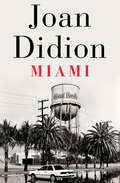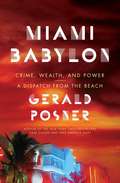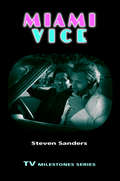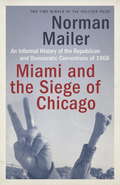- Table View
- List View
Mexico's Fuel Trafficking Phenomenon: Analysing an Emerging Black Market (St Antony's Series)
by Samuel León SáezFuel trafficking has consolidated in recent years as a paramount illegal enterprise and a priority for Mexico´s diverse criminal actors. This black market has been growing at an overwhelming pace in Mexico since 2011: it is estimated that between 2013–2018, more than 100 million barrels containing different fuels were stolen from the country´s refineries, terminals and pipelines. This academic book focuses on finding explanations as to how this came to be. By examining the Mexican fuel black market, one of the largest and most sophisticated criminal enterprises of its kind worldwide, this timely investigation shines a light on this recently relevant criminal market, which has been detected across the world, including in North and South America, the Middle East, North Africa, Europe, Southeast Asia and Sub-Saharan Africa. This book will prove of relevance for readers interested in energy and security, illicit markets, criminality, modern-day Mexico and the challenges posed by the country´s security crisis. At a wider level, this work contributes with insights on the diversification and sophistication of criminality and black markets in Mexico, Latin America and the world.
Mexico's Fuel Trafficking Phenomenon: Analysing an Emerging Black Market (St Antony's Series)
by Samuel León SáezFuel trafficking has consolidated in recent years as a paramount illegal enterprise and a priority for Mexico´s diverse criminal actors. This black market has been growing at an overwhelming pace in Mexico since 2011: it is estimated that between 2013–2018, more than 100 million barrels containing different fuels were stolen from the country´s refineries, terminals and pipelines. This academic book focuses on finding explanations as to how this came to be. By examining the Mexican fuel black market, one of the largest and most sophisticated criminal enterprises of its kind worldwide, this timely investigation shines a light on this recently relevant criminal market, which has been detected across the world, including in North and South America, the Middle East, North Africa, Europe, Southeast Asia and Sub-Saharan Africa. This book will prove of relevance for readers interested in energy and security, illicit markets, criminality, modern-day Mexico and the challenges posed by the country´s security crisis. At a wider level, this work contributes with insights on the diversification and sophistication of criminality and black markets in Mexico, Latin America and the world.
Mexico's Indigenous Communities
by Ethelia Ruiz Medrano Russ DavidsonA rich and detailed account of indigenous history in central and southern Mexico from the sixteenth to the twenty-first centuries, Mexico's Indigenous Communities is an expansive work that destroys the notion that Indians were victims of forces beyond their control and today have little connection with their ancient past. Indian communities continue to remember and tell their own local histories, recovering and rewriting versions of their past in light of their lived present. Ethelia Ruiz Medrano focuses on a series of individual cases, falling within successive historical epochs, that illustrate how the practice of drawing up and preserving historical documents-in particular, maps, oral accounts, and painted manuscripts-has been a determining factor in the history of Mexico's Indian communities for a variety of purposes, including the significant issue of land and its rightful ownership. Since the sixteenth century, numerous Indian pueblos have presented colonial and national courts with historical evidence that defends their landholdings. Because of its sweeping scope, groundbreaking research, and the author's intimate knowledge of specific communities, Mexico's Indigenous Communities is a unique and exceptional contribution to Mexican history. It will appeal to students and specialists of history, indigenous studies, ethnohistory, and anthropology of Latin America and Mexico
Mexico's Spiritual Reconquest: Indigenous Catholics and Father Pérez's Revolutionary Church
by Matthew ButlerMexico&’s Spiritual Reconquest brings to life a classically misunderstood pícaro: liberal soldier turned Catholic priest and revolutionary antipope, &“Patriarch&” Joaquín Pérez. Historian Matthew Butler weaves Pérez&’s controversial life story into a larger narrative about the relationship between religion, the state, and indigeneity in twentieth-century Mexico.Mexico&’s Spiritual Reconquest is at once the history of an indigenous reformation and a deeply researched, beautifully written exploration of what can happen when revolutions try to assimilate powerful religious institutions and groups. The book challenges historians to reshape baseline assumptions about modern Mexico in order to see a revolutionary state that was deeply vested in religion and a Cristero War that was, in reality, a culture clash between Catholics.
Mexico-United States Relations: The Semantics of Sovereignty (Routledge Studies in North American Politics)
by Arturo Santa-CruzSovereignty is a key factor to consider when studying the Mexico-United States relationship. During most of the twentieth century, as a result of the new character of the Mexican post-revolutionary regime, there was a decoupling between the state’s maximalist discourse on sovereignty, and its practice. Sovereignty as an undifferentiated whole does not exist; it should instead be disaggregated into the myriad issue areas in which it is constantly negotiated. Focusing on a tripartite classification relating to the construction of Mexico’s sovereignty towards its northern neighbor since 1920, this volume illustrates how Mexico’s sovereignty has varied not only according to the times, but also according to the issues at stake. In doing so, Arturo Santa-Cruz comprehensively covers a variety of issues in the bilateral agenda such as drug trafficking, electoral observation, human rights, investment, migration, security, and trade, as well as some defining moments in the relationship, such as the 1923 US granting of recognition to the Mexican post-revolutionary regime, the 1938 oil nationalization, the 1982 debt crisis, and the 1995 financial bailout. These diverse cases, analyzed through an original analytical approach, capture sovereignty’s multifocal meaning.
Mexico: From the Olmecs to the Aztecs
by Michael D. Coe Rex Koontz Javier UrcidMexico arrives in its eighth edition with a new look and the most recent discoveries. This is the story of the pre-Spanish people of Mexico, who, with their neighbors the Maya, formed some of the most complex societies north of the Andes. Revised and expanded, the book is updated with the latest developments and findings in the field and current terminology. The new edition includes expanded coverage of Oaxaca, particularly Monte Alba´n, one of the earliest cities in Mesoamerica and the center of the Zapotec civilization. Recent research on the Olmecs and the legacy of the Maya offer a wider and more cohesive narrative of Mexico’s history. And a fully revised epilogue discusses the survival of indigenous populations in Mexico from the arrival of the Spanish through to the present day. Mexico has long been recognized as the most readable and authoritative introduction to the region’s ancient civilizations. Featuring up-to-date research and, for the first time, full-color illustrations throughout, this book brings to life the vibrant ancient art and architecture of Mesoamerica.
Mexico: Narco-violence and a Failed State?
by George W. Grayson* Mexico was named an Outstanding Academic Title of 2010 by Choice Magazine. Bloodshed connected with Mexican drug cartels, how they emerged, and their impact on the United States is the subject of this frightening book. Savage narcotics-related decapitations, castrations, and other murders have destroyed tourism in many Mexican communities and such savagery is now cascading across the border into the United States. Grayson explores how this spiral of violence emerged in Mexico, its impact on the country and its northern neighbor, and the prospects for managing it. Mexico's Institutional Revolutionary Party (PRI) ruled in Tammany Hall fashion for seventy-nine years before losing the presidency in 2000 to the center-right National Action Party (PAN). Grayson focuses on drug wars, prohibition, corruption, and other antecedents that occurred during the PRI's hegemony. He illuminates the diaspora of drug cartels and their fragmentation, analyzes the emergence of new gangs, sets forth President Felipe Calder�n's strategy against vicious criminal organizations, and assesses its relative success. Grayson reviews the effect of narcotics-focused issues in U. S. -Mexican relations. He considers the possibility that Mexico may become a failed state, as feared by opinion-leaders, even as it pursues an aggressive but thus far unsuccessful crusade against the importation, processing, and sale of illegal substances. Becoming a "failed state" involves two dimensions of state power: its scope, or the different functions and goals taken on by governments, and its strength, or the government's ability to plan and execute policies. The Mexican state boasts an extensive scope evidenced by its monopoly over the petroleum industry, its role as the major supplier of electricity, its financing of public education, its numerous retirement and health-care programs, its control of public universities, and its dominance over the armed forces. The state has not yet taken control of drug trafficking, and its strength is steadily diminishing. This explosive book is thus a study of drug cartels, but also state disintegration.
Mexico: Why a Few Are Rich and the People Poor
by Ramon RuizExplicitly focusing on the malaise of underdevelopment that has shaped the country since the Spanish conquest, Ramón Eduardo Ruiz offers a panoramic interpretation of Mexican history and culture from the pre-Hispanic and colonial eras through the twentieth century. Drawing on economics, psychology, literature, film, and history, he reveals how development processes have fostered glaring inequalities, uncovers the fundamental role of race and class in perpetuating poverty, and sheds new light on the contemporary Mexican reality. Throughout, Ruiz traces a legacy of dependency on outsiders, and considers the weighty role the United States has played, starting with an unjust war that cost Mexico half its territory. Based on Ruiz’s decades of research and travel in Mexico, this penetrating work helps us better understand where the country has come, why it is where it is today, and where it might go in the future.
Mexico’s Drug-Related Violence (Drugs, Crime and Society)
by Omar CamarilloThis book explores and explains how traditional and alternative media have framed the issues of gun trafficking into Mexico, drug related violence, and spillover violence. It reveals how gun trafficking and drug related violence are social problems for Mexico, while spillover violence is portrayed as a moral panic for the U.S. Readers will gain a better understanding of how the media portrays and frames the criminal activity that is occurring in Mexico and how it impacts the U.S. The book analyses national newspapers from both sides of the US-Mexico border: The New York Times and El Universal, and draws on a theoretical framework of moral panics, social problems, and cultivation theory. It reveals six framing devices, “the blame game,” “worthy and unworthy victims,” “positive aspects,” “negative aspects of gun trafficking,” “indirect mention of gun trafficking,” and “direct mention of gun trafficking”, which are utilized by The New York Times and El Universal to discuss and frame the issue of gun trafficking into Mexico and its impact on Mexico’s border violence. Mexico’s Drug Related Violence will be of great interest to students and scholars interested in the perception of media and crime, as well as those who researching the topic drug cartels and drug related violence.
Mexifornia: A State of Becoming
by Victor Davis HansonRight-wing political commentator Hanson issues a broadside against Mexican immigration to California. He argues that continued immigration will lead to endemic poverty, eroded schools, soaring crime, and other problems. He presumes to describe the "mental landscape of the alien" describing immigrant life as one of poverty, frustration, envy, and inevitable degeneration. He recommends either cutting off immigration or enforcing rapid assimilation on newly arrived immigrants. Annotation (c)2003 Book News, Inc., Portland, OR (booknews.com)
Mexifornia: A State of Becoming
by Victor Davis HansonVictor Davis Hanson locates the cause of our immigration quagmire in the opportunistic coalition that stymies immigration reform and, even worse, stifles any honest discussion of the present crisis. Conservative corporations, contractors and agribusiness demand cheap wage labor from Mexico, whatever the social consequences. Meanwhile, "progressive" academics, journalists, government bureaucrats and La Raza advocates see illegal aliens as a vast new political constituency for those peddling the notion that victimhood, not citizenship, is the key to advancement. The troubles Hanson identifies may have reached critical mass in California, but they also affect Americans who inhabit "Mexizona," "Mexichusetts" and other states of becoming.Hanson follows the fortunes of Hispanic friends he has known all his life-how they have succeeded in America and how they regard the immigration quandary. But if Mexifornia is an emotionally generous look at the ambition and vigor of people who have made California strong, it is also an indictment of the policies that got California into its present mess. In the end, Hanson is hopeful that our traditions of assimilation, integration and intermarriage may yet remedy a predicament that the politicians and ideologues have allowed to get out of hand.
Mi Mundo Estudios Sociales: La formación de nuestra nación
by James B. Kracht Linda Bennett Armando Cantú AlonzoNIMAC-sourced textbook
Mi Voz, Mi Vida
by Andrew Garrod Robert Kilkenny Christina GómezAmid the flurry of debates about immigration, poverty, and education in the United States, the stories in Mi Voz, Mi Vida allow us to reflect on how young people who might be most affected by the results of these debates actually navigate through American society. The fifteen Latino college students who tell their stories in this book come from a variety of socioeconomic, regional, and family backgrounds-they are young men and women of Mexican, Puerto Rican, Cuban, Dominican, Central American, and South American descent. Their insights are both balanced and frank, blending personal, anecdotal, political, and cultural viewpoints. Their engaging stories detail the students' personal struggles with issues such as identity and biculturalism, family dynamics, religion, poverty, stereotypes, and the value of education. Throughout, they provide insights into issues of racial identity in contemporary America among a minority population that is very much in the news. This book gives educators, students, and their families a clear view of the experience of Latino students adapting to a challenging educational environment and a cultural context-Dartmouth College-often very different from their childhood ones.
Mi Voz, Mi Vida: Latino College Students Tell Their Life Stories
by Andrew Garrod Robert Kilkenny Christina GomezGarrod (education, Dartmouth College), Kilkenny (social work, Simmons College, Boston), and Goméz (sociology and Latino studies, Northeastern Illinois U. , Chicago) present a collection of 15 first-person narratives by Latino college students, aged 18 to 22, who attended Dartmouth; all but one of the essays was written within the last four years. The authors reflect on formative relationships and influences, life-changing events, and factors that helped shape their values, educational outcomes, and sense of personal identity. The text does not focus on Dartmouth per se or on its educational impact on the students, but rather on their evolving lives and Latino identities. The contributions are grouped into four major themes from the essays-- resilience, biculturalism, mentoring, and identity. For educators, college administrators, students and their families.
Mi hermana: Cómo la transición de una hermana nos cambió a ambas
by Selenis Leyva Marizol LeyvaA powerful memoir by two sisters about transitioning, family, and the path to self-realization.When Orange Is the New Black and Diary of a Future President star Selenis Leyva was young, her hardworking parents brought a new foster child into their warm, loving family in the Bronx. Selenis was immediately smitten; she doted on the baby, who in turn looked up to Selenis and followed her everywhere. The little boy became part of the family. But later, the siblings realized that the child was struggling with their identity. As Marizol transitioned and fought to define herself, Selenis and the family wanted to help, but didn't always have the language to describe what Marizol was going through or the knowledge to help her thrive.In My Sister, Selenis and Marizol narrate, in alternating chapters, their shared journey, challenges, and triumphs. They write honestly about the issues of violence, abuse, and discrimination that transgender people and women of color--and especially trans women of color--experience daily. And they are open about the messiness and confusion of fully realizing oneself and being properly affirmed by others, even those who love you.Profoundly moving and instructive, My Sister offers insight into the lives of two siblings learning to be their authentic selves. Ultimately, theirs is a story of hope, one that will resonate with and affirm those in the process of transitioning, watching a loved one transition, and anyone taking control of their gender or sexual identities.
Mi mundo adorado
by Sonia SotomayorLa primera latina y la tercera mujer designada a la Corte Suprema de Estados Unidos, Sonia Sotomayor se ha convertido en un ícono contemporáneo. Ahora, con un candor e intimidad inusitados, Sonia nos narra el viaje de su vida -desde los proyectos del Bronx hasta la corte federal- en una inspiradora celebración del poder de creer en uno mismo.Ésta es la historia de una niñez precaria, con un padre alcohólico que moriría cuando ella tenía nueve años y una madre devota pero sobrecargada, y del refugio que una niña tomó de la confusión del hogar con su enérgica abuela. Pero no fue hasta que le diagnosticaron diabetes juvenil cuando la precoz Sonia reconoció que, en última instancia, dependía de sí misma. Pronto aprendería a ponerse a sí misma las inyecciones de insulina necesarias para sobrevivir y forjar un camino hacia una vida mejor.Con personajes de televisión como modelo y con poca idea sobre lo que en realidad implicaba, Sonia decidió ser abogada, unsueño que la sostendría en su improbable recorrido, desde su brillante paso por la escuela secundaria, la Universidad de Princeton y la Escuela de Derecho de Yale hasta la Fiscalía de Distrito del Condado de Nueva York, la práctica privada, y el nombramiento a la Corte Federal de Distrito, todo antes de llegar a los cuarenta años.A lo largo del camino vemos cómo Sonia fue formada por diversas experiencias, mentores invaluables, y la versión moderna de familia que creó con sus amigos y sus hijos. Todos esos elementos se hilvanan en un libro cálido y honesto, destinado a convertirse en un clásico de la autoformación y el autodescubrimiento.
Mi mundo adorado (Vintage Espanol Ser.)
by Sonia SotomayorLa primera latina y tan sólo la tercera mujer designada a la Corte Suprema de los Estados Unidos, Sonia Sotomayor se ha convertido en un icono americano contemporáneo. Ahora, con un candor e intimidad nunca antes asumidos por un juez en activo, Sonia nos narra el viaje de su vida desde los proyectos del Bronx hasta la corte federal en una inspiradora celebración de su extraordinaria determinación y del poder de creer en uno mismo. Esta es la historia de una niñez precaria, con un padre alcohólico que moriría cuando ella tenía nueve años y una madre devota pero sobrecargada, y del refugio que una niña tomó de la confusión del hogar con su apasionada y enérgica abuela. Pero no fue hasta que le diagnosticaron diabetes juvenil que la precoz Sonia reconoció que, en última instancia, dependía de sí misma. Pronto aprendería a darse a sí misma las inyecciones de insulina necesarias para sobrevivir y a rápidamente forjar un camino hacia una vida mejor. Con personajes de televisión como modelo y poca idea sobre lo que en realidad implicaba, Sonia decidió ser abogada, un sueño que la sostendría en su improbable recorrido, desde su brillante paso por la escuela secundaria, la universidad de Princeton y la escuela de Derecho de Yale hasta la fiscalía de distrito del Condado de Nueva York, la práctica privada, y el nombramiento a la Corte Federal de Distrito, todo antes de llegar a los cuarenta años. A lo largo del camino vemos como Sonia fue formada por diversas experiencias (como su fallido matrimonio), mentores invaluables, y la versión moderna de familia que creó con amigos queridos y sus hijos. A través de sus aún asombrados ojos, las posibilidades infinitas de los Estados Unidos son vislumbradas nuevamente en este libro cálido y honesto, destinado a convertirse en un clásico de la autoformación y el autodescubrimiento.
Mi primer libro de criaturas fantásticas (The Bedtime Books)
by Stephen Krensky¡Vete a dormir acompañado de tus criaturas mágicas favoritas!El mundo está lleno de criaturas fascinantes, algunas grandes como elefantes y otras pequeñas como ratones. Desde hadas y sirenas hasta dragones y unicornios, ¡este libro para leer antes de dormir incluye más de 100 criaturas mágicas de todo tipo!Pasa las páginas de este libro para niños y descubre:Mitos, leyendas y cuentos de seres fantásticos acompañados de encantadoras ilustraciones y palabras destacadas para que los niños las aprendan y memoricen.Muchos seres imaginarios y mitológicos organizados por capítulos y en base a su tipología: seres terrestres, acuáticos y voladores.Páginas de referencia al final del libro con información adicional sobre el origen y la historia de cada criatura.Un glosario de términos con el que conocer vocabulario nuevo y una guía de pronunciación para aprender a pronunciar los nombres de las criaturas mágicas.Explora junto a tus hijos la historia de ángeles, brujas, elfos y otras muchas criaturas de culturas de todo el mundo, como Medusa de la mitología griega, el dragón Ninki Nanka de África Occidental o el Abominable Hombre de las Nieves que habita las montañas asiáticas.Un libro lleno de color, de fantasía ¡y muy divertido! Perfecto para leer en voz alta antes de dormir e imprescindible en la estantería de todo curioso lector. ¡Buenas noches!-----------------------------------Say hello to more than 100 of your favorite magical creatures with this colorful bedtime book. This is the must-have bedtime book about the world's most fantastical creatures. Turn each page to learn more about the fantastic variety of magical creatures - from fairies and mermaids to dragons and unicorns.With charming illustrations, storybook text, and key terms highlighted on each page, this book is a wonderful introduction to magical creatures. The book showcases land, water, and air beings in three chapters. Many pages are devoted to a particular creature, with others featuring a collection of similar beings, such as witches and genies, giving bite-sized chunks of accessible information to help early learners learn more about their favorite creature from myths, legends, and story books. There are also reference pages at the end of the book that give more information on the context and origins of each creature.A timeless gift book, The Bedtime Book of Magical Creatures will be treasured for years to come.
Mi primer libro de criaturas fantásticas (The Bedtime Books)
by Stephen Krensky¡Vete a dormir acompañado de tus criaturas mágicas favoritas!El mundo está lleno de criaturas fascinantes, algunas grandes como elefantes y otras pequeñas como ratones. Desde hadas y sirenas hasta dragones y unicornios, ¡este libro para leer antes de dormir incluye más de 100 criaturas mágicas de todo tipo!Pasa las páginas de este libro para niños y descubre:Mitos, leyendas y cuentos de seres fantásticos acompañados de encantadoras ilustraciones y palabras destacadas para que los niños las aprendan y memoricen.Muchos seres imaginarios y mitológicos organizados por capítulos y en base a su tipología: seres terrestres, acuáticos y voladores.Páginas de referencia al final del libro con información adicional sobre el origen y la historia de cada criatura.Un glosario de términos con el que conocer vocabulario nuevo y una guía de pronunciación para aprender a pronunciar los nombres de las criaturas mágicas.Explora junto a tus hijos la historia de ángeles, brujas, elfos y otras muchas criaturas de culturas de todo el mundo, como Medusa de la mitología griega, el dragón Ninki Nanka de África Occidental o el Abominable Hombre de las Nieves que habita las montañas asiáticas.Un libro lleno de color, de fantasía ¡y muy divertido! Perfecto para leer en voz alta antes de dormir e imprescindible en la estantería de todo curioso lector. ¡Buenas noches!-----------------------------------Say hello to more than 100 of your favorite magical creatures with this colorful bedtime book. This is the must-have bedtime book about the world's most fantastical creatures. Turn each page to learn more about the fantastic variety of magical creatures - from fairies and mermaids to dragons and unicorns.With charming illustrations, storybook text, and key terms highlighted on each page, this book is a wonderful introduction to magical creatures. The book showcases land, water, and air beings in three chapters. Many pages are devoted to a particular creature, with others featuring a collection of similar beings, such as witches and genies, giving bite-sized chunks of accessible information to help early learners learn more about their favorite creature from myths, legends, and story books. There are also reference pages at the end of the book that give more information on the context and origins of each creature.A timeless gift book, The Bedtime Book of Magical Creatures will be treasured for years to come.
Mia Mia Aboriginal Community Development
by Michael Wright Cheryl Kickett-Tucker Dawn Bessarab Juli CoffinUntil recently, Aboriginal people have been subjected to mainly top-down development, which has proven damaging to communities. Mia Mia Aboriginal Community Development offers an alternative to such approaches, promoting cultural security in order to empower Aboriginal people to strengthen their own communities. The authors take a multidisciplinary approach to the topics of Aboriginal community development, Aboriginal history, cultural security and community studies. This book includes chapters examining historical and contemporary Aboriginal conceptions of community development, and the effects of post-structuralism, post-modernism, globalisation and digital technology. As well as comprehensive analysis of community development in Aboriginal communities, it presents practical strategies and tools for improvement. Each chapter includes practical case studies and review exercises, encouraging active learning and reflection. A valuable resource for tertiary education students, this book features contributions from some of Australia's most eminent Aboriginal scholars, Elders and Aboriginal community members alongside contributions from community development practitioners.
Miami
by Joan DidionThe subject of this book is the fateful relationship between Cuban exiles of Miami and the larger body politic of the United States. Didion describes a place in which two profoundly different cultures co-exist, apparently with no understanding of each other, and where the myths of Cuban exile have not only become the everyday stuff of local politics, but have spread out from Miami to the White House and beyond.
Miami (Classics Of Reportage Ser.)
by Joan DidionAn astonishing account of Cuban exiles, CIA informants, and cocaine traffickers in Florida by the New York Times–bestselling author of South and West. In Miami, the National Book Award–winning author of The Year of Magical Thinking looks beyond postcard images of fluorescent waters, backlit islands, and pastel architecture to explore the murkier waters of a city on the edge. From Fidel Castro and the Bay of Pigs invasion to Lee Harvey Oswald and the Kennedy assassination to Oliver North and the Iran–Contra affair, Joan Didion uncovers political intrigues and shadowy underworld connections, and documents the US government&’s &“seduction and betrayal&” of the Cuban exile community in Dade County. She writes of hotels that offer &“guerrilla discounts,&” gun shops that advertise Father&’s Day deals, and a real-estate market where &“Unusual Security and Ready Access to the Ocean&” are perks for wealthy homeowners looking to make a quick escape. With a booming drug trade, staggering racial and class inequities, and skyrocketing murder rates, Miami in the 1980s felt more like a Third World capital than a modern American city. Didion describes the violence, passion, and paranoia of these troubled times in arresting detail and &“beautifully evocative prose&” (The New York Times Book Review). A vital report on an immigrant community traumatized by broken dreams and the cynicism of US foreign policy, Miami is a masterwork of literary journalism whose insights are timelier and more important than ever.
Miami Babylon
by Gerald PosnerHere, in all its neon-colored, cocaine-fueled glory, is the never-before-told story of the making of Miami Beach. Gerald Posner, author of the groundbreaking investigations Case Closed and Why America Slept, has uncovered the hair-raising political-financial-criminal history of the Beach and reveals a tale that, in the words of one character, "makes Scarface look like a documentary." From its beginnings in the 1890s, the Beach has been a place made by visionaries and hustlers. During Prohibition, Al Capone had to muscle into its bootlegging and gambling businesses. After December 1941, when the Beach was the training ground for half a million army recruits, even the war couldn't stop the party. After a short postwar boom, the city's luck gave out. The big hotels went bankrupt, the crime rate rose, and the tourists moved on to Disney World and the Caribbean. Even after the Beach hosted both national political conventions in 1972, nobody would have imagined that this sandy backwater of run-down hotels and high crime would soon become one of the country's most important cultural centers. But in 1981, 125,000 Cubans arrived by the boatload. The empty streets of South Beach, lined with dilapidated Art Deco hotels, were about to be changed irrevocably by the culture of money that moved in behind cocaine and crime. Posner takes us inside the intertwined lives of politicians, financiers, nightclub owners, and real estate developers who have fed the Beach's unquenchable desire for wealth, flash, and hype: the German playboy who bought the entire tip of South Beach with $100 million of questionable money; the mayoral candidate who said, "If you can't take their money, drink their liquor, mess with their women, and then vote against them, you aren't cut out for politics"; the Staten Island thug who became king of the South Beach nightclubs only to have his empire unravel and saved himself by testifying against the mob; the campaign manager who calls himself the "Prince of Darkness" and got immunity from prosecution in a fraud case by cooperating with the FBI against his colleagues; and the former Washington, D. C. , developer who played hardball with city hall and became the Beach's first black hotel owner. From the mid-level coke dealers and their suitcases of cash to the questionable billions that financed the ocean-view condo towers, the Beach has seen it all. Posner's singular report tells the real story of how this small urban beach community was transformed into a world-class headquarters for American culture within a generation. It is a story built by dreamers and schemers. nd a steroid-injected cautionary tale.
Miami Vice: Miami Vice
by Steven SandersDiscusses the aesthetic appeal, production history, philosophical themes, and enduring importance of the groundbreaking 1980s television series.
Miami and the Siege of Chicago
by Norman Mailer<p>In this landmark work of journalism, Norman Mailer reports on the presidential conventions of 1968, the turbulent year from which today’s bitterly divided country arose. <p>The Vietnam War was raging; Martin Luther King, Jr., and Robert F. Kennedy had just been assassinated. In August, the Republican Party met in Miami and picked Richard Nixon as its candidate, to little fanfare. <p>But when the Democrats backed Lyndon Johnson’s ineffectual vice president, Hubert Humphrey, the city of Chicago erupted. Antiwar protesters filled the streets and the police ran amok, beating and arresting demonstrators and delegates alike, all broadcast on live television—and captured in these pages by one of America’s fiercest intellects.
